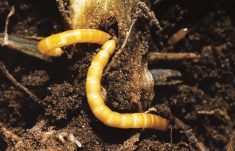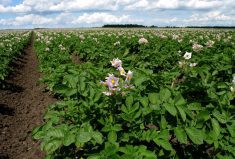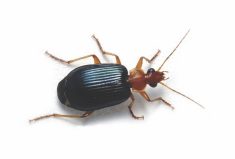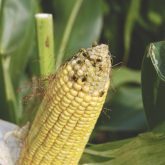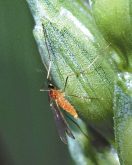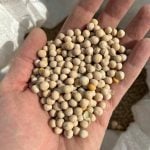At what point is it too late for control? This is a question Prairie producers ask every year, and every year the answer is slightly different, depending on weather and the state of the crop.
This year, many producers had to decide how firmly to respond to pest pressures hovering around the economic threshold. Scott Meers, Alberta’s provincial entomologist, says this was the case for flea beetles in canola in the province.
“If the crop is not doing well, we have to be more sensitive about control — be more aggressive in applying the economic threshold, rather than waiting for things to develop,” he said in an interview. “I think what happened was that a lot of fields were below threshold, and then we came back a few days later and things were bad.”
Scott Hartley, the provincial entomologist in Saskatchewan, says the same was true for aphids in Saskatchewan cereals. “This year, there were aphids in everything, almost every crop,” he said.
Aphids are uncommon in cereals, and this year, they either arrived too late or populations did not reach economic levels until late in the year. “In the later cereal crops, control would have been worthwhile, but in many, by the time the aphids were noticed, the crops were too advanced to warrant control,” he said.

Across the Prairies, aphids and grasshoppers emerged as the most significant general pest threats, affecting almost all crops, particularly in Alberta and Saskatchewan. In Manitoba, cutworms were also a significant problem for most crops, according to John Gavloski, the province’s head entomologist.
For canola, cereals and pulses, a variety of pest pressures across the Prairies kept all three entomologists on their toes in 2015.
Canola
In canola, flea beetles emerged as the pest of greatest concern across the Prairies.
In Manitoba, Gavloski said seed treatment to manage early-season flea beetle populations is common in the province, but feeding damage affected crops at or above threshold levels in early-season canola once treatments wore off, forcing producers to spray. “Late May through June, they were a big issue,” he said.
Read Also

Producers aren’t panicking over tariffs and trade threats
The influence of tariff and trade uncertainity on farm business decisions.
Hartley said that due to Saskatchewan’s early spring, flea beetle populations were higher than the province had seen in years.
“Even though we did get some good heat, we had cool nights, dry conditions and slow growth for a while, which meant that canola seedlings were more vulnerable to flea beetle,” Hartley said. “When you have higher numbers than you’ve seen in a while, producers have to refresh themselves on control options and scouting for certain pests.”
Meers said flea beetle pressure was high in Alberta for similar reasons. “The canola crop was not growing aggressively — this year it was very slow to develop,” he said.
Across Saskatchewan and Alberta, producers saw a significant northern range expansion for cabbage seed pod weevil. The weevil survey indicated significant populations as far north as Kindersley. It is also established as far east as Indian Head.
Cabbage seed pod weevil is a perennial issue in Alberta, but the pest pushed a surprising distance north. “Numbers were more or less normal in the established range, which is essentially Highway 1 and south, but we saw a fairly substantial range expansion into the Lacombe area,” Meers said.
Bertha army worm counts were low in Alberta and Saskatchewan, and remained below threshold in 2015 in Manitoba. Diamondback moth similarly remained below threshold levels in all provinces.
Swede midge, an invasive pest first detected in Ontario in 2000, was found in Saskatchewan in 2007, according to Hartley, but was picked up in significant numbers only in 2012.
“Surveys by AAFC found that it has a broad distribution across the northern Grain Belt from Nipawin and Carrot River across through Prince Albert toward Lloydminster and North Battleford,” Hartley said. Swede midge was detected this year just across the Alberta border. Only very low levels of swede midge have been detected in Manitoba.
Cereals
In Manitoba, the biggest pest threat facing cereals was army worm, which blows in from the south. But this year Gavloski noted an uprising against the pest from a surprising source — a small back parasitic wasp known as Cotesia.

“In mid-July I was getting a lot of people sending photos of what they suspected were egg masses on top of the cereal plants. They were actually clusters of pupal cases for Cotesia,” Gavloski said. “The army worm population was heavily parasitized. We do often get a second generation of army worms, but we didn’t notice much of a second generation this year, so the parasitism knocked things back quite a bit.”
Army worm was less of an issue in Saskatchewan and Alberta, where grasshoppers presented a bigger threat.
Meers said grasshoppers presented a greater problem this year than last year in Alberta. “It’s a double-edged sword — in dry springs, the crops don’t do as well and the grasshoppers do very well, so the damage is worse than the numbers would indicate. We’re poised for a big increase in grasshopper numbers if we get another dry spring next year.”
Grasshopper numbers built up through the southwest, west-central and east-central areas of Saskatchewan, Hartley said.
In both Saskatchewan and Alberta, there were large populations of English grain aphid that although normally green was pigmented orange this year, likely due to environmental conditions.
Pulses
By far the greatest pest threats facing Saskatchewan pulse producers this year were aphids and grasshoppers, according to Hartley.
Grasshoppers have been sprayed for the last few years in lentils, where threshold levels are extremely low — two grasshoppers per square metre.
“Economic thresholds tend to go down any time the insect is feeding on the yield component, such as lentil pods, where there’s a direct effect on yields,” Hartley said.
Alberta saw a range expansion for pea leaf weevil. “We’ve always considered it a southern Alberta pest, but we had very serious high numbers into the Lacombe area, and we were finding it on fababeans as far north as Edmonton in the fall, so it’s made a major jump north,” said Meers.
Expansion in pea leaf weevil range seems to be following fababean acreage expansion, but Meers said it’s too soon to tell what is causing the increase.
Manitoba’s only significant pest concern in pulses was soybean aphid. “But overall it was moderate — we have seen much worse,” Gavloski said. “A lot depends on when they arrive. And once again we noticed a lot of natural enemies in soybean fields, and quite a few people let the natural enemies take care of aphids.”
Gavloski believes producers are becoming much more aware of natural enemies of insect pests, and at times willing to let them regulate potential pests. “Many producers are willing to wait and see if natural enemies can regulate pest levels, rather than quickly resort to insecticides,” he said. “A lot of them get concerned when they have a high-value crop, but at the same time they would like to let nature take its course.”




